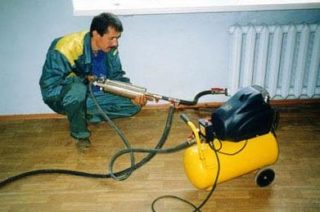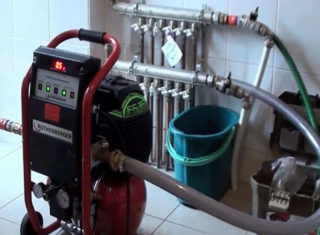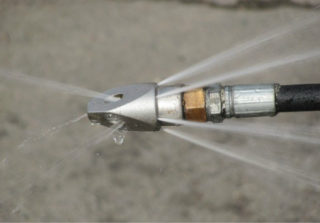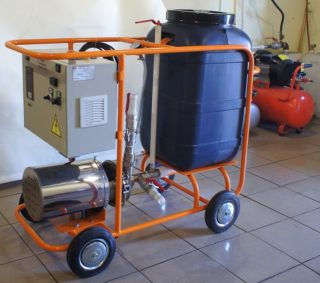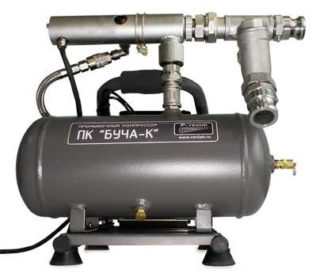Flushing heating pipes is an event that should be carried out regularly, regardless of the form of ownership of the property and its configuration. In the absence of proper maintenance, the lines become clogged, which can cause a critical situation. In the best case, the coolant circulation worsens and it becomes cold in the apartment. The worst case scenario is a break or freeze system. With a competent approach, you can clean the heating pipes yourself, saving a considerable amount on the services of professionals. To do this, you need to deal with the causes of pollution and methods of self-cleaning pipes.
Signs of poor heating
Experts recommend flushing the heating system every 5-6 years. In areas where water is characterized by increased hardness and acidity, this procedure should be carried out more often.
The fact that pipe cleaning is necessary is indicated by the following phenomena:
- Uneven heating of the batteries. In some apartments or rooms, the temperature is normal, in other places the radiators are cold or slightly warm.
- High blood pressure. Information about this can be obtained in the basement of the house, where manometers are installed on risers. Pressure arises from the difficulty of fluid passing through narrowed places.
- Loud noise in the highway. It occurs due to turbulence in the pipes caused by the difference in the volume of water in different places of the system.
- Actuation of safety valves - bleed valve and air vent.
- Leaking at the joints. In some cases, due to extremely high pressure, it tears off the valves and bursts in the weak points of the pipe.
When identifying such signs, it is necessary to act promptly. The situation will worsen further, and exponentially, as old deposits quickly collect a new raid.
Causes of pollution
The preconditions for clogging of the heating system can be chemical, technical, or physical. Also, the human factor cannot be ruled out.
Causes of blockages:
- The chemical composition of water. The liquid circulating through the pipes does not undergo electrolytic cleaning. Under the influence of high temperature metals are released from it - iron, calcium and magnesium, which form a dense precipitate.
- Corrosion of iron. Almost all the wiring in the houses of the old building was made of steel. Only recently has polypropylene products been used for this. Rust accumulates on the walls of the pipes, gradually reducing their internal section.
- Emergency situations. When highways break through, dirt, plants and small stones fall into them. After the repair is completed, extraneous inclusions are carried along the pipeline, sticking to its surface.
- Errors in the construction and repair. These include poor-quality welding at the joints, resulting in narrowed places where dirt gathers faster. Sometimes craftsmen drop gaskets, tow, small metal parts stuck at corners and joints into pipes.
- Shape and size of radiators. Cast iron products have a large volume, water flows more slowly in them, which contributes to the precipitation.
To determine the causes of clogging of communications, they should be diagnosed. This can be done using a probe or an ultrasound scanner. Determining the nature of the contamination will help you choose the best way to fix the problem.
Heating system flushing options
The choice of technology for flushing the heating system in an apartment building depends not only on the composition, quantity and size of blockages. It is necessary to take into account the composition of the materials from which the closed loop is made, its scheme and the types of crimping used. Iron, cast iron and polymer plastic products can be installed on one riser. A potent chemical or pressure can damage one of them. Therefore, it is necessary to act so that flushing does not cause the destruction of the system and its costly repair. This process can be carried out according to one of the options available today, which is selected individually.
Mechanical
This method is more focused on radiators than piping and risers. The advantage of this approach is that it can be carried out at any time of the year, regardless of whether the heating system works or is turned off for the warm season. The main condition is the presence of cranes in front of the radiators and the existing thread at their ends.
After closing the water, the heating element must be disconnected from the harness. It must be removed carefully so as not to damage the floor and walls. Then the product must be taken outside or placed in a trough. The battery can be cleaned with a plumbing cable with a removable brush of the appropriate size. You can blow sections with a powerful compressor. If the heating is turned off, it makes sense to perform similar manipulations with the piping. The cable with the brush is pushed to the riser, which is less than horizontal sections prone to the formation of sediment.
After mechanical action, the radiator and pipes are washed with water until all contaminants are removed. After installing the heater in place, check the tightness of the connection.
Chemical
The chemical method of cleaning the circuit is the most affordable of all that you can do with your own hands. Another plus is that if there is a pipe with a tap, flushing can be done with the heating system running. The essence of the method is that chemicals, acting on the precipitate, cause its softening, decomposition into small fragments and dissolution.
The following solutions have these properties:
- lemon acid;
- alkali (sodium hydroxide NaOH);
- phosphoric acid (P2O5 • nH2O).
These substances are harmless to metal and plastic, but destructive to foreign objects in the system.
Reagents are pumped into the system using a pump connected to the nozzle, which is responsible for the circulation of the liquid. Depending on the properties of the solution, it takes 2-8 hours to completely remove the precipitate. This period is indicated in the manufacturer's instructions.
Waste material is poured into a separate container and disposed of. If this is not possible, a deactivator is added to the solution. Drain contaminated water into the sewer is prohibited.
Hydrodynamic
The hydrodynamic method is used to flush channels of large volume and length. The use of chemistry for such highways is economically disadvantageous. Therefore, a more effective but difficult approach is used. Its essence is that a hose is introduced into the pipe, through which a liquid with abrasive additives is supplied under high pressure. The destruction of plaque occurs due to friction and impact. If the plaque is thick, it will take a lot of time and effort to remove it. To achieve the desired effect, it is necessary to remove all internal filters. Unnecessary obstacles to the medium’s circulation reduce its speed and delay washed material.
Hydropneumatic
The hydropneumatic method has been used to service pipelines since the middle of the last century.This technology is characterized by low cost and high efficiency. The essence of the method is the complex effect on the deposition of chemicals and pressure.
At the initial stage, the circuit closes, a compressor is connected to it. The circulation is performed alternately in different directions, which contributes to a faster and better result. At the final stage, the liquid under strong pressure is discharged into the collector, taking with it all the pollution.
Electrohydropulse
This technique is based on the impact of water on clogged areas. There is no risk of damage to fittings, rupture of plastic and aluminum pipes. Since water is an incompressible substance, this property underlies the technology.
Flushing the heating is carried out by special equipment of shock type. A water cannon fires a stream that breaks deposits from the walls, destroys deaf bridges and carries away foreign objects. The wave moves at a speed of up to 1500 m / s, creating a pressure of up to 12 atmospheres. The cleaning effect is observed at a distance of 60 meters from the installation site.
Flushing Instructions
Do-it-yourself purge of the heating system is an event that consists of several stages. First you need to determine the cause and nature of the blockages. After this, the necessary tools, equipment and materials should be prepared. To save on the rental of expensive appliances, it is advisable to stop on the chemical method, requiring minimal application of effort and material costs.
To work, you will need:
- compressor of sufficient power;
- centrifugal pump;
- electric pumping station;
- plumbing pliers;
- containers for collecting waste fluid;
- pipes;
- clamping fittings;
- soldering iron for plastic;
- Bulgarian.
Depending on the characteristics of the building and the circumstances, the list can be reduced or expanded.
To clean the heating system in an apartment building, the following actions are carried out:
- An announcement is announced in advance about the need for tenants to be in apartments for the duration of the communications service.
- The gate valve is blocked. The coolant is discharged into the sewage system.
- A centrifugal pump is connected to the measuring valve.
- In tanks, the treatment fluid is prepared. The compressor hose is lowered into the tank, the circuit is filled.
- The pump turns on and circulation begins. After the set time, the condition of the solution is checked. It is discharged into the collector or storage tanks.
- The system is filled with clean water, which is run through it several times. The reset is done again. If clean water comes out, the goal has been achieved.
At the end of the process, the condition of the connecting elements is checked. If they are covered with rust or have served the warranty period, fittings are best replaced.
Flushing an autonomous system in a private home is simpler, faster, and cheaper due to the incomparability of sizes, distances, and volumes. If the structure is one-story, cleaning can be carried out without a compressor, due to the natural circulation of the solution when heated. For houses with a height of 2 floors or more, a pump is required.
The work is performed in the following sequence:
- The tightness of the pipeline is checked. Preparing a rag and a container for collecting spilled liquid.
- The concentrated solution is mixed. Through the expansion tank, it is filled into the circuit.
- The boiler turns on to a low fire. Due to the difference in temperature, circulation begins. If necessary, the pump or compressor starts. The condition of the reagent is periodically monitored.
After cleaning, the reagent is drained and disposed of.The system is flushed with clean water and can be used for its intended purpose.
